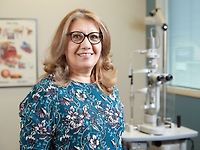Today
Description
Hamilton Eye Clinic are experts in cataract surgery and cover all aspects of eye surgery and ophthalmic care. This ensures our patients receive the highest standard of treatment and personalised care.
We have been providing comprehensive ophthalmic care to the greater Waikato region for over 30 years.
The Clinic operates out of the Bridgewater Building on Grantham Street, beside the Waikato River, in the heart of Hamilton. We also operate satellite clinics from Cambridge, Huntly, Matamata, Morrinsville, and Thames and are equipped with a range of machines and the latest equipment and technological advances available for patient care.
Among our various services, we offer specialist treatment and management for the following:
- Cataract Surgery
- Refractive Surgery
- Glaucoma
- Oculoplastic and Lacrimal Surgery
- Medical and Surgical Retina
- Strabismus
- Medical Laser Treatment
- Neuro Ophthalmology
- Visual Electrophysiology
- Macular Degeneration
- Acute Eye Conditions
- General Ophthalmology
- Cornea and Corneal Surgery
- Keratoconus
What is Ophthalmology?
Ophthalmology is the branch of specialist medicine that is focused on the health of eyes and their surrounding tissues, including muscles, bones, eyelids, and tear production/drainage systems. Your eye is the organ of vision and consists of the cornea (the outer clear layer), the sclera (the white of the eye), the iris (the coloured part), the lens (lies behind the iris) and the retina (the light-sensitive lining at the back of the eye). Your eyes ‘see’ by focusing light that enters the eye onto the retina which sends the image to the brain by the optic nerve.
Ophthalmologists are doctors who are trained in the study of the eyes. Most will be trained in eye surgery and may have particular areas of interest or expertise.
Consultants
Note: Please note below that some people are not available at all locations.
-

Dr John Dickson
Ophthalmologist
Available at 130 Grantham Street, Hamilton
-

Dr Reid Ferguson
Ophthalmologist
Available at all locations.
-

Dr Stephen Guest
Ophthalmologist
Available at 130 Grantham Street, Hamilton
-

Dr Benjamin Hoy
Ophthalmologist
Available at 130 Grantham Street, Hamilton
-

Dr Thiyagaraj Krishnan
Ophthalmologist
Available at 130 Grantham Street, Hamilton, 33 Duke Street, Cambridge
-

Dr Selma Matloob
Ophthalmologist
Available at 130 Grantham Street, Hamilton
-

Dr Michael Merriman
Ophthalmologist
Available at 130 Grantham Street, Hamilton
-

Dr Bheema Patil
Ophthalmologist
Available at 130 Grantham Street, Hamilton, Pohlen Hospital Complex, 56 Rawhiti Avenue, Matamata, 19 Allen Street, Morrinsville
-

Dr Rohan Weerekoon
Ophthalmologist
Available at 130 Grantham Street, Hamilton, 125 Main Street, Huntly, 817 Rolleston Street, Thames
-

Dr David Worsley
Ophthalmologist
Available at 130 Grantham Street, Hamilton
Referral Expectations
If you need to see one of our specialists, and it is not ACC related, a referral from your GP or optometrist is preferred as your eye health information that comes with the referral is very useful to our ophthalmologists. However you can refer yourself or a family member directly and we will happily see you at one of our clinics.
If your eye health concern is ACC related you will need a referral from a GP or have all of the information about the injury available so we can complete the necessary paperwork.
Patients can read more of what to expect on your appointment in our Patient Information page.
GPs & optometrists can find more information and referral details here. Our referral e-mail address is or if you use Medtech 32 Specialist Referrals the eReferral will be received at the Hamilton Clinic. General referrals can be sent to Hamilton Eye Clinic rather than a specific doctor.
Fees and Charges Description
Please contact us for details of our consultation and surgery charges as these vary between specialists.
We are able to process medical insurance charges from all insurers and we are a Southern Cross Affiliated provider for a number of procedures. We will assist in form completion and pre-approval of your claim.
Hours
| Mon – Fri | 8:00 AM – 5:00 PM |
|---|
Please note some clinics may run after 5:00pm to assist with after work appointments.
Public Holidays: Closed Auckland Anniversary (26 Jan), Waitangi Day (6 Feb), Good Friday (3 Apr), Easter Sunday (5 Apr), Easter Monday (6 Apr), ANZAC Day (observed) (27 Apr), King's Birthday (1 Jun), Matariki (10 Jul), Labour Day (26 Oct).
Christmas: Open 22 Dec — 24 Dec. Closed 25 Dec — 28 Dec. Open 29 Dec — 31 Dec. Closed 1 Jan — 4 Jan. Open 5 Jan — 9 Jan.
Procedures / Treatments
Cataracts are the most common age-related occurrence in eyes. The lens becomes thicker and stiffer and appears yellow and cloudy. Eventually it may turn white, changing the colour of the pupil. A cataract may cause your vision to become fuzzy in a progressive fashion and may also be the cause of disabling glare. Once a cataract affects vision too much, a cataract removal operation is generally advised. This decision is usually made in consultation with an eye specialist. The operation is almost always done under local anaesthetic. Once the cataract has been removed an artificial lens is put in to replace it. It is relatively short in duration and an overnight stay in hospital is not required. Postoperative care consists of eye drops and usually involves a check at 1-2 days then after 2-4 weeks but may vary between doctors. Click here to find a patient information brochure about cataract surgery.
Cataracts are the most common age-related occurrence in eyes. The lens becomes thicker and stiffer and appears yellow and cloudy. Eventually it may turn white, changing the colour of the pupil. A cataract may cause your vision to become fuzzy in a progressive fashion and may also be the cause of disabling glare. Once a cataract affects vision too much, a cataract removal operation is generally advised. This decision is usually made in consultation with an eye specialist. The operation is almost always done under local anaesthetic. Once the cataract has been removed an artificial lens is put in to replace it. It is relatively short in duration and an overnight stay in hospital is not required. Postoperative care consists of eye drops and usually involves a check at 1-2 days then after 2-4 weeks but may vary between doctors. Click here to find a patient information brochure about cataract surgery.
A weakness in one or more of the muscles of the eye will cause the eye to turn or move away from the normal focusing position. This is commonly known as a squint. A squint can be corrected by surgery, or by using glasses. Rarely, children may grow out of a squint. Surgical correction of squint usually involves a general anaesthetic. In the procedure, the muscles involved are repositioned to correct the alignment. It is important to recognise and treat a squint as, if left uncorrected, it can result in permanent impairment of vision.
A weakness in one or more of the muscles of the eye will cause the eye to turn or move away from the normal focusing position. This is commonly known as a squint. A squint can be corrected by surgery, or by using glasses. Rarely, children may grow out of a squint. Surgical correction of squint usually involves a general anaesthetic. In the procedure, the muscles involved are repositioned to correct the alignment. It is important to recognise and treat a squint as, if left uncorrected, it can result in permanent impairment of vision.
A weakness in one or more of the muscles of the eye will cause the eye to turn or move away from the normal focusing position. This is commonly known as a squint. A squint can be corrected by surgery, or by using glasses. Rarely, children may grow out of a squint. Surgical correction of squint usually involves a general anaesthetic. In the procedure, the muscles involved are repositioned to correct the alignment. It is important to recognise and treat a squint as, if left uncorrected, it can result in permanent impairment of vision.
Glaucoma is a group of diseases that can damage the eye’s optic nerve and may result in vision loss and blindness. Multiple factors are often important in causing glaucoma, but it is most commonly related to an increase in pressure in the eye. Symptoms are generally absent until the condition has progressed to an advanced stage. Very occasionally, a rarer form of glaucoma can develop suddenly in which case symptoms may include: headaches and aches around the affected eye, seeing halos around lights, sensitivity to light, blurred vision, nausea and vomiting. You may be more likely to develop glaucoma if you: have someone else in your family with glaucoma already have high pressure in your eye have experienced injury to your eye currently have or have had certain other eye problems have migraine or circulation problems Glaucoma is most common in people over 50 years of age and more common in women than men. Diagnosis usually comes after consultation with an eye doctor. Signs of glaucoma may also be picked up at an optometrist eye examination. The following tests are used to diagnose and monitor glaucoma: Tonometry – measures eye pressure. It is often the first screening test for glaucoma. The eyes are numbed with eye drops and then examined. Dilated eye exam - this is done with an ophthalmoscope (which is a medical instrument that allows the doctor to look through the pupil to the back of the eye).The retina and optic nerve are then examined for any sign of damage. Visual acuity test – test to check distance vision using an eye chart. Visual field test – test to measure side (peripheral) vision. Pachymetry – test to measure the thickness of the cornea. Many other new techniques are emerging to help identify the likelihood of glaucoma and determine its rate of worsening. Although glaucoma cannot be cured, early treatment can prevent further worsening of the condition and vision loss. Regular eye examinations will need to be continued life-long. Eye drops to decrease eye pressure are the most common early treatment. Surgery may be required, especially if medications are not taking adequate effect. Laser trabeculoplasty, in which a surgeon uses a laser to help the fluid drain from the eye, may be considered in some cases, but has limited effectiveness. More commonly, a trabeculectomy may be performed when other methods have failed to adequately control pressure. This is a medium length operation that makes a new opening for fluid to drain from the eye. Click here to find a patient information brochure about glaucoma.
Glaucoma is a group of diseases that can damage the eye’s optic nerve and may result in vision loss and blindness. Multiple factors are often important in causing glaucoma, but it is most commonly related to an increase in pressure in the eye. Symptoms are generally absent until the condition has progressed to an advanced stage. Very occasionally, a rarer form of glaucoma can develop suddenly in which case symptoms may include: headaches and aches around the affected eye, seeing halos around lights, sensitivity to light, blurred vision, nausea and vomiting. You may be more likely to develop glaucoma if you: have someone else in your family with glaucoma already have high pressure in your eye have experienced injury to your eye currently have or have had certain other eye problems have migraine or circulation problems Glaucoma is most common in people over 50 years of age and more common in women than men. Diagnosis usually comes after consultation with an eye doctor. Signs of glaucoma may also be picked up at an optometrist eye examination. The following tests are used to diagnose and monitor glaucoma: Tonometry – measures eye pressure. It is often the first screening test for glaucoma. The eyes are numbed with eye drops and then examined. Dilated eye exam - this is done with an ophthalmoscope (which is a medical instrument that allows the doctor to look through the pupil to the back of the eye).The retina and optic nerve are then examined for any sign of damage. Visual acuity test – test to check distance vision using an eye chart. Visual field test – test to measure side (peripheral) vision. Pachymetry – test to measure the thickness of the cornea. Many other new techniques are emerging to help identify the likelihood of glaucoma and determine its rate of worsening. Although glaucoma cannot be cured, early treatment can prevent further worsening of the condition and vision loss. Regular eye examinations will need to be continued life-long. Eye drops to decrease eye pressure are the most common early treatment. Surgery may be required, especially if medications are not taking adequate effect. Laser trabeculoplasty, in which a surgeon uses a laser to help the fluid drain from the eye, may be considered in some cases, but has limited effectiveness. More commonly, a trabeculectomy may be performed when other methods have failed to adequately control pressure. This is a medium length operation that makes a new opening for fluid to drain from the eye. Click here to find a patient information brochure about glaucoma.
- have someone else in your family with glaucoma
- already have high pressure in your eye
- have experienced injury to your eye
- currently have or have had certain other eye problems
- have migraine or circulation problems
- Tonometry – measures eye pressure. It is often the first screening test for glaucoma. The eyes are numbed with eye drops and then examined.
- Dilated eye exam - this is done with an ophthalmoscope (which is a medical instrument that allows the doctor to look through the pupil to the back of the eye).The retina and optic nerve are then examined for any sign of damage.
- Visual acuity test – test to check distance vision using an eye chart.
- Visual field test – test to measure side (peripheral) vision.
- Pachymetry – test to measure the thickness of the cornea.
This is a complication of diabetes and is caused by small blood vessel damage within the retina of the eye. It commonly affects both eyes and may cause permanent loss of vision. Macular oedema is sometimes also present with diabetic retinopathy. Macular oedema is when fluid leaks into the retina and causes swelling and blurred vision. This may occur at any stage of diabetic retinopathy, but is more common as the disease progresses. There are often no symptoms in the early stages but as the condition progresses vision may begin to become impaired. Often visual loss may be sudden and without warning. This is why it is imperative that at-risk diabetics have frequent eye checks. Poorly controlled diabetes and pregnancy in diabetes are risk factors for developing this condition. Often, first-stage diabetic retinopathy requires no active treatment on the eye but requires stabilisation of diabetes and regular eye examinations. With progressive retinopathy, a laser treatment called the PRP laser can be used. This works by shrinking enlarged blood vessels to prevent further bleeding into the retina. Severe bleeding may require a surgical procedure called a vitrectomy, where blood is surgically removed from the eye. Treatment of macular oedema, if present, is by focal laser treatment. Vision is stabilised by reducing the degree of fluid leakage into the retina. Often more than one treatment is required. Click here to find a patient information brochure about diabetes and diabetic retinopathy.
This is a complication of diabetes and is caused by small blood vessel damage within the retina of the eye. It commonly affects both eyes and may cause permanent loss of vision. Macular oedema is sometimes also present with diabetic retinopathy. Macular oedema is when fluid leaks into the retina and causes swelling and blurred vision. This may occur at any stage of diabetic retinopathy, but is more common as the disease progresses. There are often no symptoms in the early stages but as the condition progresses vision may begin to become impaired. Often visual loss may be sudden and without warning. This is why it is imperative that at-risk diabetics have frequent eye checks. Poorly controlled diabetes and pregnancy in diabetes are risk factors for developing this condition. Often, first-stage diabetic retinopathy requires no active treatment on the eye but requires stabilisation of diabetes and regular eye examinations. With progressive retinopathy, a laser treatment called the PRP laser can be used. This works by shrinking enlarged blood vessels to prevent further bleeding into the retina. Severe bleeding may require a surgical procedure called a vitrectomy, where blood is surgically removed from the eye. Treatment of macular oedema, if present, is by focal laser treatment. Vision is stabilised by reducing the degree of fluid leakage into the retina. Often more than one treatment is required. Click here to find a patient information brochure about diabetes and diabetic retinopathy.
This is when the retina detaches, meaning it is lifted or separated from its normal position within the eye. An acute retinal detachment requires urgent assessment and appropriate treatment. Unless prompt and effective treatment is given, some forms of retinal detachment may lead to irreversible blindness. Signs and symptoms include: a sudden or gradual increase in floaters, deterioration in vision, cobwebs or specks with the visual field, light flashes in the eye or the appearance of curtains over the visual field. You are more likely to have a retinal detachment if you are very short-sighted or have had an injury or previous surgery to the eye. For minor detachments, a laser or freeze treatment (cryopexy) are used. Both therapies re-attach the retina. For major detachment, surgery will be necessary. A band is often put around the back of the eye to prevent further detachment. Surgical treatment is usually a vitrectomy, where the jelly (vitreous) is removed from the eye. This often involves a hospital stay. It can take several months post-surgery to see the final visual result. Click here to find a patient information brochure about floaters, flashers and retinal detachment.
This is when the retina detaches, meaning it is lifted or separated from its normal position within the eye. An acute retinal detachment requires urgent assessment and appropriate treatment. Unless prompt and effective treatment is given, some forms of retinal detachment may lead to irreversible blindness. Signs and symptoms include: a sudden or gradual increase in floaters, deterioration in vision, cobwebs or specks with the visual field, light flashes in the eye or the appearance of curtains over the visual field. You are more likely to have a retinal detachment if you are very short-sighted or have had an injury or previous surgery to the eye. For minor detachments, a laser or freeze treatment (cryopexy) are used. Both therapies re-attach the retina. For major detachment, surgery will be necessary. A band is often put around the back of the eye to prevent further detachment. Surgical treatment is usually a vitrectomy, where the jelly (vitreous) is removed from the eye. This often involves a hospital stay. It can take several months post-surgery to see the final visual result. Click here to find a patient information brochure about floaters, flashers and retinal detachment.
This is when the retina detaches, meaning it is lifted or separated from its normal position within the eye. An acute retinal detachment requires urgent assessment and appropriate treatment. Unless prompt and effective treatment is given, some forms of retinal detachment may lead to irreversible blindness.
Signs and symptoms include: a sudden or gradual increase in floaters, deterioration in vision, cobwebs or specks with the visual field, light flashes in the eye or the appearance of curtains over the visual field. You are more likely to have a retinal detachment if you are very short-sighted or have had an injury or previous surgery to the eye.
For minor detachments, a laser or freeze treatment (cryopexy) are used. Both therapies re-attach the retina. For major detachment, surgery will be necessary. A band is often put around the back of the eye to prevent further detachment. Surgical treatment is usually a vitrectomy, where the jelly (vitreous) is removed from the eye. This often involves a hospital stay. It can take several months post-surgery to see the final visual result.
Click here to find a patient information brochure about floaters, flashers and retinal detachment.
Disability Assistance
Wheelchair access, Wheelchair accessible toilet, Mobility parking space, Assistance to move around
Document Downloads
-
Cataract Surgery Brochure
(PDF, 2.2 MB)
A cataract is a clouding or opacity of the lens inside the eye. To understand cataracts, learning about how the eye works is helpful.
Inside the eye, behind the coloured part (the iris) with a black hole in the middle (the pupil), is the lens. In a normal eye, this lens is clear. It helps focus light rays on the back of the eye (the retina), which sends messages to the brain, allowing us to see.
When a cataract develops, the lens becomes cloudy, preventing the light rays from passing through.
Refreshments
Our patient reception area has tea and coffee making facilities and filtered water for your convenience. Please help yourself to this complimentary service.
Travel Directions
Please see our useful map to find our location on Grantham Street.
Parking
Free off street parking is provided for patients at the main south-end entrance to the Bridgewater Building site. Look for the specially marked car parks - "Eye Patients Only"
Accommodation
We can suggest nearby accommodation options if you have a need for an overnight stay. Please ask the secretary for your doctor to help with this.
Security
Our Clinic at Bridgewater is managed through a building security system. The main doors are automatically locked between 5pm and 8am.
If you arrive before 8am you can use the intercom system in the building lobby to contact the receptionist to open the doors for you.
If you are leaving after 5pm you will need to manually open the doors, the buttons for the main door and the external door are clearly marked. If you are having any difficulty please ask a secretary to help you.
Other
Informative patient brochures can be found here.
Website
Contact Details
125 Main Street, Huntly
Waikato
-
Phone
(07) 834 0006
-
Fax
(07) 839 4918
Healthlink EDI
hecanbds
Email
Website
Use our online enquiry form
To contact your chosen specialist use the numbers below:
- Dr Thiyagaraj Krishnan (07) 960 2109
- Dr Benjamin Hoy: (07) 834 6330
- Dr Bheema Patil: (07) 834 6304
- Dr David Worsley: (07 834 6334
- Dr John Dickson: (07) 834 6332
- Dr Michael Merriman: (07) 834 6308
- Dr Rohan Weerekoon: (07) 834 6336
- Dr Selma Matloob: (07) 834 6308
- Dr Stephen Guest: (07) 834 6331
- Dr Stephen Ng: (07) 960 2169
125 Main Street
Huntly
Waikato
Street Address
125 Main Street
Huntly
Waikato
Postal Address
130 Grantham Street
Hamilton
Waikato 3204
130 Grantham Street, Hamilton
Waikato
-
Phone
(07) 834 0006
-
Fax
(07) 839 4918
Healthlink EDI
hecanbds
Email
Website
Pohlen Hospital Complex, 56 Rawhiti Avenue, Matamata
Waikato
-
Phone
(07) 834 0006
-
Fax
(07) 839 4918
Healthlink EDI
hecanbds
Email
Website
817 Rolleston Street, Thames
Waikato
-
Phone
(07) 834 0006
-
Fax
(07) 839 4918
Healthlink EDI
hecanbds
Email
Website
19 Allen Street, Morrinsville
Waikato
-
Phone
(07) 834 0006
-
Fax
(07) 839 4918
Healthlink EDI
hecanbds
Email
Website
33 Duke Street, Cambridge
Waikato
-
Phone
(07) 834 0006
-
Fax
(07) 839 4918
Healthlink EDI
hecanbds
Email
Website
Was this page helpful?
This page was last updated at 12:53PM on June 16, 2025. This information is reviewed and edited by Hamilton Eye Clinic.

